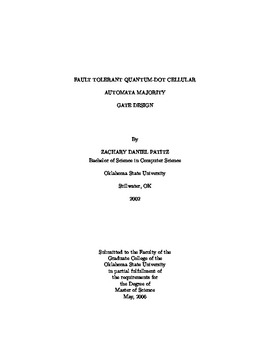| dc.contributor.advisor | Park, Nohpill | |
| dc.contributor.author | Patitz, Zachary Daniel | |
| dc.date.accessioned | 2014-04-15T18:33:08Z | |
| dc.date.available | 2014-04-15T18:33:08Z | |
| dc.date.issued | 2006-05-01 | |
| dc.identifier.uri | https://hdl.handle.net/11244/8220 | |
| dc.description.abstract | The purpose of this study was to examine the fault-tolerance of Quantum-dot Cellular Automata structures, namely the Majority gate. The focus of the fault-tolerance of these structures was under differing radii of effect distances. The structure of the majority gates is pivotal to the construction of complex arrays in QCA. The fault-tolerance of majority gates in QCA greatly impacts the flexibility of the clocking scheme and, therefore the entire design of the array. Testing was done with the aid of a simulation tool using realistic environment variables. The proposed fault-tolerant majority gates were found to function appropriately under a single clock control. The impact of this finding was greatly increased clock zone placement flexibility as well as a reduced amount of clocking zones for a simple carry-look-ahead full-adder. | |
| dc.format | application/pdf | |
| dc.language | en_US | |
| dc.publisher | Oklahoma State University | |
| dc.rights | Copyright is held by the author who has granted the Oklahoma State University Library the non-exclusive right to share this material in its institutional repository. Contact Digital Library Services at lib-dls@okstate.edu or 405-744-9161 for the permission policy on the use, reproduction or distribution of this material. | |
| dc.title | Fault Tolerant Quantum-dot Cellular Automata Majority Gate Design | |
| dc.type | text | |
| dc.contributor.committeeMember | George, K. M. | |
| dc.contributor.committeeMember | Sarangan, V. | |
| osu.filename | Patitz_okstate_0664M_1816.pdf | |
| osu.college | Arts and Sciences | |
| osu.accesstype | Open Access | |
| dc.description.department | Computer Science Department | |
| dc.type.genre | Thesis | |
